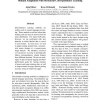Free Online Productivity Tools
i2Speak
i2Symbol
i2OCR
iTex2Img
iWeb2Print
iWeb2Shot
i2Type
iPdf2Split
iPdf2Merge
i2Bopomofo
i2Arabic
i2Style
i2Image
i2PDF
iLatex2Rtf
Sci2ools
EMNLP
2006
2006
Domain Adaptation with Structural Correspondence Learning
Discriminative learning methods are widely used in natural language processing. These methods work best when their training and test data are drawn from the same distribution. For many NLP tasks, however, we are confronted with new domains in which labeled data is scarce or non-existent. In such cases, we seek to adapt existing models from a resourcerich source domain to a resource-poor target domain. We introduce structural correspondence learning to automatically induce correspondences among features from different domains. We test our technique on part of speech tagging and show performance gains for varying amounts of source and target training data, as well as improvements in target domain parsing accuracy using our improved tagger.
| Added | 30 Oct 2010 |
| Updated | 30 Oct 2010 |
| Type | Conference |
| Year | 2006 |
| Where | EMNLP |
| Authors | John Blitzer, Ryan T. McDonald, Fernando Pereira |
Comments (0)

